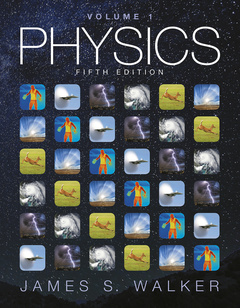Description
Physics, Volume 1 (5th Ed.)
Author: Walker James
Language: English
Subject for Physics, Volume 1:
736 p. · 22x27.6 cm · Paperback
Description
/li>Contents
/li>Biography
/li>Comment
/li>
Intended for algebra-based introductory physics courses.
An accessible, problem-solving approach to physics, grounded in real-world applications
James Walker?s Physics provides students with a solid conceptual understanding of physics that can be expressed quantitatively and applied to the world around them. Instructors and students praise Walker?s Physics for its friendly voice, the author?s talent for making complex concepts understandable, an inviting art program, and the range of excellent homework problems and example-types that provide guidance with problem solving. The Fifth Edition, Volume 1 (Chapters 1-18) includes new ?just-in-time? learning aids such as ?Big Ideas? to quickly orient students to the overarching principles of each chapter, new Real-World Physics and Biological applications, and a wealth of problem-solving support features to coach students through the process of applying logic and reasoning to problem solving.
Also Available with MasteringPhysics
MasteringPhysics from Pearson is the leading online homework, tutorial, and assessment system, designed to improve results by engaging students before, during, and after class with powerful content. Instructors ensure students arrive ready to learn by assigning educationally effective content before class and encourage critical thinking and retention with in-class resources such as Learning Catalytics. Students can further master concepts after class through traditional and adaptive homework assignments that provide hints and answer-specific feedback. The Mastering gradebook records scores for all automatically graded assignments in one place, while diagnostic tools give instructors access to rich data to assess student understanding and misconceptions.
Mastering brings learning full circle by continuously adapting to each student and making learning more personal than ever?before, during, and after class.
Note: You are purchasing a standalone product; MasteringPhysics does not come packaged with this content. Students, if interested in purchasing this title with MasteringPhysics, ask your instructor for the correct package ISBN and Course ID. Instructors, contact your Pearson representative for more information.
Physics, 5th Edition includes Chapters 1-32 but is also available as 2 separate volumes:
- Volume 1 contains Chapters 1-18
- Volume 2 contains Chapters 19-32
- Introduction to Physics
I. MECHANICS
- One-Dimensional Kinematics
- Vectors in Physics
- Two-Dimensional Kinematics
- Newtons Laws of Motion
- Applications of Newtons Laws
- Work and Kinetic Energy
- Potential Energy and Conservation of Energy
- Linear Momentum and Collisions
- Rotational Kinematics and Energy
- Rotational Dynamics and Static Equilibrium
- Gravity
- Oscillations About Equilibrium
- Waves and Sound
- Fluids
II. THERMAL PHYSICS
- Temperature and Heat
- Phases and Phase Changes
- The Laws of Thermodynamics
III. ELECTROMAGNETISM
- Electric Charges, Forces, and Fields
- Electric Potential and Electric Potential Energy
- Electric Current and Direct-Current Circuits
- Magnetism
- Magnetic Flux and Faradays Law of Induction
- Alternating-Current Circuits
IV. LIGHT AND OPTICS
- Electromagnetic Waves
- Geometrical Optics
- Optical Instruments
- Physical Optics: Interference and Diffraction
V. MODERN PHYSICS
- Relativity
- Quantum Physics
- Atomic Physics
- Nuclear Physics and Nuclear Radiation
About our author
James Walker obtained his Ph.D. in theoretical physics from the University of Washington in 1978. He subsequently served as a post-doc at the University of Pennsylvania, the Massachusetts Institute of Technology, and the University of California at San Diego before joining the physics faculty at Western Washington University. Professor Walker's research interests include statistical mechanics, critical phenomena, and chaos. His many publications on the application of renormalization-group theory to systems ranging from absorbed monolayers to binary-fluid mixtures have appeared in Physical Review, Physical Review Letters, Physica, and a host of other publications. He has also participated in observations on the summit of Mauna Kea, looking for evidence of extra-solar planets.
Jim Walker likes to work with students at all levels, from judging elementary school science fairs to writing research papers with graduate students, and has taught introductory physics for many years. His enjoyment of this course and his empathy for students have earned him a reputation as an innovative, enthusiastic, and effective teacher. Jim's educational publications include "Reappearing Phases" (Scientific American, May 1987) as well as articles in the American Journal of Physics and The Physics Teacher. In recognition of his contributions to the teaching of physics at Western Washington University, Jim was named the Boeing Distinguished Professor of Science and Mathematics Education for 2001-2003.
When he is not writing, conducting research, teaching, or developing new classroom demonstrations and pedagogical materials, Jim enjoys amateur astronomy, eclipse chasing, bird and dragonfly watching, photography, juggling, unicycling, boogie boarding, and kayaking. Jim is also an avid jazz pianist and organist. He has served as ballpark organist for a number of Class A minor league baseball teams, including the Bellingham Mariners, an af
These books may interest you

Physics, Volume 2 190.98 €



